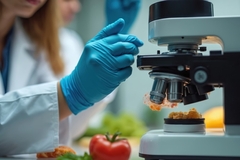
- Industry news
Industry news
- Category news
Category news
- Reports
- Key trends
- Multimedia
- Journal
- Events
- Suppliers
- Home
- Industry news
Industry news
- Category news
Category news
- Reports
- Key trends
- Multimedia
- Events
- Suppliers
Interplanetary plants: Vertical farming pioneer takes agri-tech to space for earthly ideas

21 Aug 2023 --- The UK Space Agency has selected UK-based vertical farming firm Vertical Future to lead a project that aims to develop a Controlled Environment Agriculture (CEA) facility to support space exploration. The project learnings will also be applied to vertical farming on Earth to advance urban agriculture capabilities.
As Dr. Jennifer Bromley, chief scientific officer at Vertical Future, points out, astronauts typically lack access to a varied diet while in space, which is an issue the project is working to solve by providing high-quality produce that can be grown on a space vessel.
“While this project may sound like the plotline of The Martian, it is important to develop new and innovative ways for astronauts to survive and thrive in their ventures to not just the Moon but Mars and beyond,” she says.

Vertical Future – which claims to be the first UK-based firm to work in the agri-space sector after securing this research grant – will team up with international experts in plant biology and space technologies, including Axiom Space, Saber Astronautics and the University of Southern Queensland, along with its Plants for Space research partners at the University of Adelaide and the University of Cambridge.
Lessons from space
On Earth, vertical farming is attracting investment for its potential to produce crops cost-effectively and at scale by minimizing the need for labor and resource inputs such as water, energy, fertilizer and pesticides. Moreover, the agri-tech reduces reliance on imports and avoids extreme weather events that are increasingly devastating conventional farms.
The CEA space trials have comparable outputs with Earth-based vertical farming in terms of understanding how plants grow and systems operate. But the researchers also expect to witness and learn from key differences between the two environments. Vertical Future and its partners aim to advance space exploration by providing astronauts with nutritious foods grown onboard vessels.
Vertical Future and its partners aim to advance space exploration by providing astronauts with nutritious foods grown onboard vessels.
“Growing plants in space poses challenges when it comes to controlling the environment and how this impacts systems, where resources including water and nutrients are limited due to the space location. Everything you need to grow the plants has to be taken into orbit and recycled effectively to get the maximum output for the cost of getting it there,” Bromley tells Food Ingredients First.
“There is also the impact of plant metabolism and transpiration (the loss of water through leaves) and how this potentially impacts a sensitive environment such as the International Space Station (ISS).”
Meanwhile, growing plants in low gravity conditions has already been studied in several trials on the ISS, while much is known about how crops respond to gravity from tests on Earth.
Preparing for liftoff
Phase One of the project will research the design requirements for a fully-autonomous agriculture system that can be monitored and operated remotely or through the use of AI, supporting space explorations like future Moon-to-Mars Artemis missions.
NASA’s Kennedy Space Center will host a workshop where the project team can develop the specifications for a CEA facility onboard the ISS that can cope with the constraints and challenges found in deep space.
The team will also test data transfer requirements between Vertical Future’s facilities at its R&D site in London, UK, and The Waite Research Institute, University of Adelaide, Australia.
“We’re hopeful that we will be carrying out trials in space within Phase Two, which we hope to initiate in 2024. As a member of the Plants 4 Space ARC Centre of Excellence, this project sits within a larger program, which will have trials in space in the next few years,” Bromley tells us.
Phase Two will focus on implementing the CEA system on the ISS and into the world’s first commercial space station, which is currently being developed by project partner Axiom Space. The Axiom Station is designed to ultimately replace the ISS at the end of its life. Vertical farming trials onboard the International Space Station will provide learnings to progress agri-tech on Earth.
Vertical farming trials onboard the International Space Station will provide learnings to progress agri-tech on Earth.
Food for the journey
Governments and companies like SpaceX continue to push the boundaries of space exploration, but providing adequate nutrition for astronauts on increasingly lengthy journeys remains an obstacle.
But Bromley is encouraged by several studies suggesting that the physical and mental health impacts of providing meal replacements to astronauts over a medium-term can be mitigated by the provision of fresh food with varying flavor and texture.
“Growing food in space also has the added benefit of the mass of starting material needed,” she continues. “A seed weighs less than a gram yet can produce hundreds of grams of fresh produce using recycled water from circular streams. The cost of getting this starting material into orbit is then significantly less and allows for a more cost-effective launch.”
Dr. Jason Held, CEO of Saber Astronautics, adds: “Sending plants to space is key to survival in long-duration space travel and plans for future settlement. Making plants thrive in space will take a mix of experts in botany, engineering and operations to make it happen.”
NASA is also working to supply nutritious and sustainable feed to astronauts embarking on longer and more complex space missions. The US agency recently completed the second phase of its Deep Space Food Challenge, with the five winning teams working on technologies to prolong the shelf life of food in space. Innovations include mushroom-based ingredients, proteins from “thin-air” and controlled-environment biofarms.
By Joshua Poole











